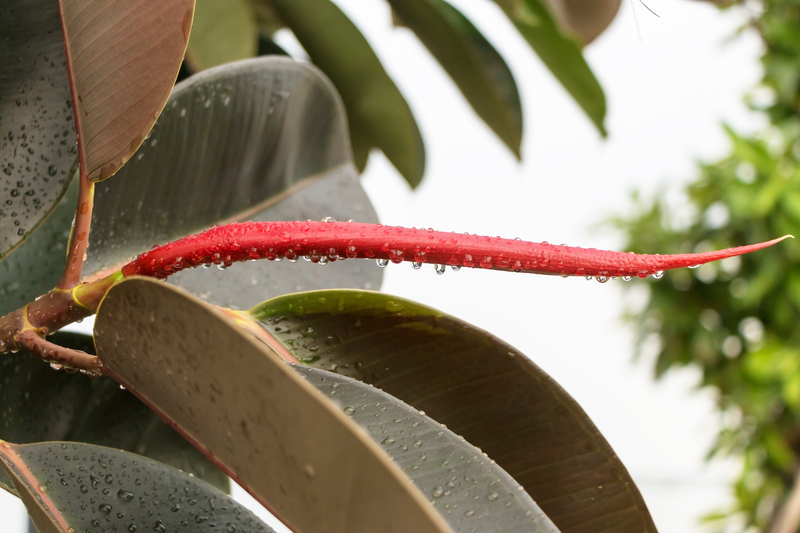Compact spaces, abundant greens with vertical gardening
Posted on 31/05/2025
Compact Spaces, Abundant Greens with Vertical Gardening: Transform Your Home Today
In an era where urban living is the norm, maximizing limited spaces has become a necessity. The growing desire to integrate nature into our lives--no matter the size of our homes--has led to the rise of compact spaces, abundant greens with vertical gardening. This gardening trend not only helps you make the most of tight quarters but also fills your environment with lush, vibrant greenery. In this in-depth guide, we'll explore innovative ways to incorporate abundant greenery into compact living spaces through vertical gardening, discuss the benefits, suggest best plants, and provide pro tips for beginners and seasoned enthusiasts alike.

What is Vertical Gardening?
Vertical gardening is the practice of growing plants upwards on structures such as walls, trellises, or specially designed panels. Unlike traditional gardening, which requires extensive horizontal space, vertical gardens leverage unused vertical real estate--making it possible for even the smallest homes or apartments to flourish in greenery.
Why Choose Vertical Gardens for Compact Spaces?
- Maximize limited floor space: Utilize walls, balconies, and fences.
- Create microclimates: Plants can help regulate indoor temperature and humidity.
- Aesthetic appeal: Cascading plants or colorful blooms can become living works of art.
- Enhance indoor air quality: Plants absorb pollutants and release oxygen.
- Boost wellbeing: Being surrounded by greenery promotes relaxation and creativity.
Exploring the Benefits: Abundant Greens in Miniature Homes
Living in compact spaces doesn't mean sacrificing the joys of gardening. On the contrary, vertical setups can create abundant green spaces in even the smallest footprint. Here are some compelling reasons to adopt this modern gardening solution:
1. Space Efficiency
In apartments, studios, small balconies, and urban homes, every inch of space counts. Vertical gardens allow you to grow more plants per square meter by stacking them upwards instead of spreading them out horizontally.
2. Improved Air Quality
Plants are natural air purifiers. When placed in vertical arrangements, they can filter out toxins like formaldehyde, benzene, and other common indoor pollutants. This helps create a healthier living environment.
3. Thermal Insulation and Noise Reduction
Adding abundant greens with vertical gardening to interior or exterior walls can act as a natural insulator, keeping heat out during summer and retaining warmth in winter. Moreover, living green walls help absorb sound, reducing noise pollution both inside and out.
4. Enhanced Aesthetics
Vertical gardens turn bland walls into attractive, living art pieces. They can serve as natural privacy screens, partitions, or visually striking focal points in compact spaces.
5. Increase Property Value
Stylish green features can boost curb appeal and value of your property, making compact homes feel more upscale and inviting.
Creative Ways to Introduce Vertical Garden Designs in Compact Homes
The possibilities for vertical gardening in small spaces are limited only by imagination. Here are popular approaches to achieving a thriving, abundant green oasis:
1. Wall Planters and Living Walls
- Modular planters: Purchase or DIY modular pockets and mount them on a wall. Fill each pocket with a different herb, flower, or trailing houseplant for a patchwork effect.
- Wall-mounted shelves: Attach staggered shelves to the wall and fill with potted plants for a tiered effect.
- Living wall panels: Specialized systems feature built-in irrigation and are perfect for dense, lush green coverage indoors.
2. Hanging Gardens
- Macrame plant hangers: Suspend plants from the ceiling to make use of vertical airspace.
- Ladder gardens: Lean a wooden ladder against the wall and use the rungs as shelves for your pots.
- Stacked planters: Consider tiered or pyramid-style planters to grow multiple species in a compact footprint.
3. Balcony Rail Planters
For apartments with balconies, rail planters make it easy to display cascading flowers or herbs without losing precious floor space.
4. Repurposed Furniture
Upcycle a bookshelf, chest of drawers, or old pallet into a vertical herb or flower garden. This approach adds rustic charm and a sustainable touch to your home.
5. Trellis and Climbing Plants
Add a trellis to your balcony, patio, or an empty wall. Grow climbing species like Pothos, Philodendron, or Jasmine for a lush, green effect.
Best Plants for Vertical Gardening in Compact Spaces
Not all plants are suitable for vertical gardening, especially in tight environments. Here's a curated list of the best plants for compact vertical gardens:
Indoor Vertical Gardens
- Pothos (Epipremnum aureum): Hardy, thrives in low light, and trails beautifully.
- Philodendron: Lush, leafy, and quick to climb or drape.
- Spider Plant (Chlorophytum comosum): Easy to care for, air-purifying.
- Peace Lily (Spathiphyllum): Adds elegance and purifies air.
- English Ivy (Hedera helix): Fast-growing climber, great for wall coverage.
- Boston Fern (Nephrolepis exaltata): Excellent in humid conditions; provides dense foliage.
- Succulents (e.g., Echeveria, Sedum): Ideal for bright areas; require minimal watering.
Outdoor Vertical Gardens
- Herbs: Basil, parsley, thyme, oregano, and mint are compact and flavorful additions.
- Flowering annuals: Petunias, pansies, impatiens, and nasturtiums for splashes of color.
- Strawberries: Small fruiting plants - perfect for edible vertical gardens.
- Climbing roses or jasmine: Excellent for trellises or fences.
- Vegetables: Lettuces, kale, and radishes grow well in vertical planters.
How to Start Your Own Compact Vertical Garden
Ready to dive in? Here's a step-by-step guide to building your own vertical garden, maximizing greenery in limited spaces:
Step 1: Assess Your Space
Identify which walls, fences, or areas receive sufficient sunlight. Consider dimensions and whether the area is suitable for mounting planters or supporting plant weight.
Step 2: Choose Your Structure
- For indoor gardens: Use modular living wall panels, repurposed shelving, or hangers.
- For balconies: Invest in rail-mounted planters or create a trellis system.
- For external walls: Use weather-resistant planters with built-in irrigation if possible.
Step 3: Select Appropriate Plants
Match plants to the sunlight and humidity levels of your chosen area. Mix trailing, climbing, and bushy plants for texture and coverage.
Step 4: Plan the Layout
Arrange plants by their size and light needs. Place shade-lovers at the bottom or on less sunlit sides, and sun-lovers at the top or where the most direct light falls.
Step 5: Plant and Install
- Use lightweight potting mixes and secure plants firmly in containers.
- Ensure drainage holes to prevent root rot.
- Fix your structure firmly to prevent tipping or collapse--especially on walls.
Step 6: Maintain Your Green Oasis
- Water regularly; consider drip irrigation for larger setups.
- Fertilize monthly for lush growth.
- Prune to keep plants within bounds and encourage bushiness.
- Watch for pests and remove dead foliage promptly.
Frequently Asked Questions About Vertical Gardening in Compact Spaces
1. Do vertical gardens damage walls?
Properly installed vertical gardens should not damage walls. Use waterproof liners or backings to protect interior surfaces and ensure good drainage to prevent dampness or mold.
2. Are vertical gardens high maintenance?
Once established, most vertical gardens are relatively low maintenance. Automated irrigation systems can further simplify care. Regular checks help keep plants healthy and thriving.
3. What are the costs involved?
The cost of setting up a vertical garden depends on size, materials, and automation. DIY projects with repurposed items can be very affordable, while large-scale living walls with built-in irrigation are more of an investment.
4. Can I grow edible plants in my compact vertical garden?
Absolutely! Many herbs, strawberries, lettuce varieties, and even dwarf vegetables do well in vertical planters, bringing fresh flavors to your kitchen right from your living wall.

Expert Tips for Thriving Abundant Greens in Small Vertical Gardens
- Rotate plants seasonally: Swap out annuals or temperature-sensitive species to keep your living wall looking fresh year-round.
- Incorporate a mix of greenery: Combine leafy, flowering, and trailing plants for maximum visual interest and ecological benefit.
- Use lightweight materials: Choose planters and soils that don't overload your structures or walls.
- Plan for growth: Leave enough space between young plants for them to mature.
- Address lighting needs: Supplement natural light with grow lamps in dimmer rooms to ensure healthy growth.
Conclusion: Create Lush, Vertical Green Spaces No Matter Your Home Size
In summary, compact spaces, abundant greens with vertical gardening is an elegant and practical solution for anyone looking to enjoy a verdant living space, regardless of square footage. Whether you dream of a lush indoor wall, a fragrant herb tower on your balcony, or a flowering patio trellis, vertical gardening opens up endless possibilities for cultivating a green oasis in even the smallest homes.
By utilizing your vertical space efficiently, choosing the right plants, and following some straightforward care guidelines, you can enjoy the health, beauty, and tranquility of nature indoors and out. Let vertical gardens transform your compact home into a sanctuary of abundant greenery--no lawn or sprawling yard required!
Start your vertical gardening journey today and discover how much green you can pack into your compact space!



